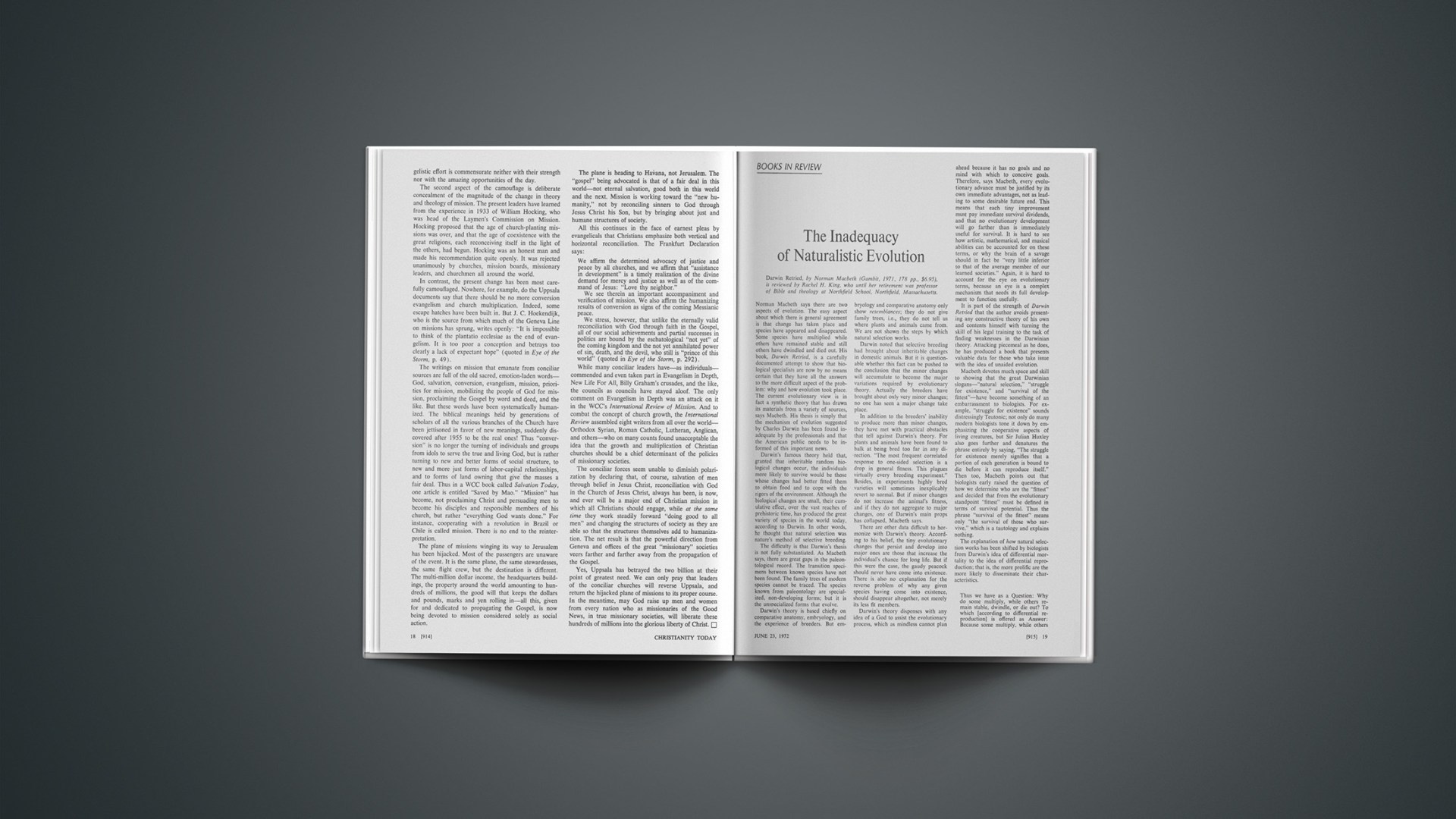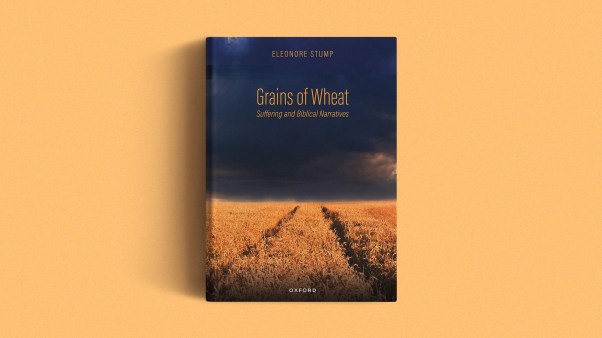The Inadequacy Of Naturalistic Evolution
Darwin Retried, by Norman Macbeth (Gambit, 1971, 178 pp., $6.95), is reviewed by Rachel H. King, who until her retirement was professor of Bible and theology at Northfield School, Northfield, Massachusetts.
Norman Macbeth says there are two aspects of evolution. The easy aspect about which there is general agreement is that change has taken place and species have appeared and disappeared. Some species have multiplied while others have remained stable and still others have dwindled and died out. His book, Darwin Retried, is a carefully documented attempt to show that biological specialists are now by no means certain that they have all the answers to the more difficult aspect of the problem: why and how evolution took place. The current evolutionary view is in fact a synthetic theory that has drawn its materials from a variety of sources, says Macbeth. His thesis is simply that the mechanism of evolution suggested by Charles Darwin has been found inadequate by the professionals and that the American public needs to be informed of this important news.
Darwin’s famous theory held that, granted that inheritable random biological changes occur, the individuals more likely to survive would be those whose changes had better fitted them to obtain food and to cope with the rigors of the environment. Although the biological changes are small, their cumulative effect, over the vast reaches of prehistoric time, has produced the great variety of species in the world today, according to Darwin. In other words, he thought that natural selection was nature’s method of selective breeding.
The difficulty is that Darwin’s thesis is not fully substantiated. As Macbeth says, there are great gaps in the paleontological record. The transition specimens between known species have not been found. The family trees of modern species cannot be traced. The species known from paleontology are specialized, non-developing forms; but it is the unspecialized forms that evolve.
Darwin’s theory is based chiefly on comparative anatomy, embryology, and the experience of breeders. But embryology and comparative anatomy only show resemblances; they do not give family trees, i.e., they do not tell us where plants and animals came from. We are not shown the steps by which natural selection works.
Darwin noted that selective breeding had brought about inheritable changes in domestic animals. But it is questionable whether this fact can be pushed to the conclusion that the minor changes will accumulate to become the major variations required by evolutionary theory. Actually the breeders have brought about only very minor changes; no one has seen a major change take place.
In addition to the breeders’ inability to produce more than minor changes, they have met with practical obstacles that tell against Darwin’s theory. For plants and animals have been found to balk at being bred too far in any direction. “The most frequent correlated response to one-sided selection is a drop in general fitness. This plagues virtually every breeding experiment.” Besides, in experiments highly bred varieties will sometimes inexplicably revert to normal. But if minor changes do not increase the animal’s fitness, and if they do not aggregate to major changes, one of Darwin’s main props has collapsed, Macbeth says.
There are other data difficult to hormonize with Darwin’s theory. According to his belief, the tiny evolutionary changes that persist and develop into major ones are those that increase the individual’s chance for long life. But if this were the case, the gaudy peacock should never have come into existence. There is also no explanation for the reverse problem of why any given species having come into existence, should disappear altogether, not merely its less fit members.
Darwin’s theory dispenses with any idea of a God to assist the evolutionary process, which as mindless cannot plan ahead because it has no goals and no mind with which to conceive goals. Therefore, says Macbeth, every evolutionary advance must be justified by its own immediate advantages, not as leading to some desirable future end. This means that each tiny improvement must pay immediate survival dividends, and that no evolutionary development will go farther than is immediately useful for survival. It is hard to see how artistic, mathematical, and musical abilities can be accounted for on these terms, or why the brain of a savage should in fact be “very little inferior to that of the average member of our learned societies.” Again, it is hard to account for the eye on evolutionary terms, because an eye is a complex mechanism that needs its full development to function usefully.
It is part of the strength of Darwin Retried that the author avoids presenting any constructive theory of his own and contents himself with turning the skill of his legal training to the task of finding weaknesses in the Darwinian theory. Attacking piecemeal as he does, he has produced a book that presents valuable data for those who take issue with the idea of unaided evolution.
Macbeth devotes much space and skill to showing that the great Darwinian slogans—“natural selection,” “struggle for existence,” and “survival of the fittest”—have become something of an embarrassment to biologists. For example, “struggle for existence” sounds distressingly Teutonic; not only do many modern biologists tone it down by emphasizing the cooperative aspects of living creatures, but Sir Julian Huxley also goes further and denatures the phrase entirely by saying, “The struggle for existence merely signifies that a portion of each generation is bound to die before it can reproduce itself.” Then too, Macbeth points out that biologists early raised the question of how we determine who are the “fittest” and decided that from the evolutionary standpoint “fittest” must be defined in terms of survival potential. Thus the phrase “survival of the fittest” means only “the survival of those who survive,” which is a tautology and explains nothing.
The explanation of how natural selection works has been shifted by biologists from Darwin’s idea of differential mortality to the idea of differential reproduction; that is, the more prolific are the more likely to disseminate their characteristics.
Thus we have as a Question: Why do some multiply, while others remain stable, dwindle, or die out? To which [according to differential reproduction] is offered as Answer: Because some multiply, while others remain stable, dwindle, or die out. The two sides of the equation are the same. We have a tautology. The definition is meaningless [p. 47].
This looks like the hair-splitting of the legal mind. But such difficulties which Macbeth analyzes are a pinpointing of the problem of the philosophical implications of evolution when biology is seen within the larger intellectual framework. Biology, to be thoroughly scientific, tries to explain living things on the basis of the accumulation of chance variations, without assigning any role to such anthropomorphic concepts as God, value, consciousness, and purpose or goal-seeking. But “fittest” is a value word, and “struggle” and “selection” both imply purpose or goal-seeking. Macbeth has put his finger on the predicament in which scientists find themselves when biology, now grown self-conscious, tries to account for evolution in consciousless, goal-less, and valueless terms.
Although Macbeth has performed an important service in making it clear that science is not a monolithic structure impervious to criticism, one should not assume that because some revision of Darwin’s theory may be necessary, the widespread naturalistic view of human life and its origins has therefore been refuted. Darwin is only one key figure in a large intellectual movement.
Christianity needs to meet the challenge posed by the inadequacy of naturalistic science with more than the negative verdict of Macbeth on Darwin. We need to fit the data of science into the comprehensive picture revealed in the Bible. One must begin with the biblical God who thought the universe into existence out of nothing. My own book, The Creation of Death and Life (Philosophical Library, 1970), is an attempt to situate the biblical doctrine of God and creation in the contemporary landscape, so dominated by the complex of facts, interpretations, and speculations associated with the concept of evolution. To do so, however, requires considerable rethinking of evolutionary assumptions and conclusions. Even granting that species, including man, have slowly reached their present state by preserving and “stockpiling” age-long small changes for the better, we are still in a position to show, on the basis of the scientific evidence, that naturalistic evolution cannot be true. For naturalistic evolution always assumes that it is “natural” for complicated conscious organisms to evolve from inanimate matter. But one of the basic laws of physics, the Second Law of Thermodynamics, makes it clear that the over-all tendency of all matter is to disintegrate into randomness, with energy irreversibly passing to the non-available state. The increasing organization that characterizes evolution involves only an infinitesimal per cent of all matter, and even so organisms soon succumb in death to the stranglehold of the over-all tendency to cosmic decay.
As Christians we can conceive that matter’s steady loss of power, after it was cast free from the divine Mind at creation, is as the withering of the branch cut off from the parent vine, God being the only self-sustaining source of power. Evolution would then result from God’s active desire to bring into existence creatures potentially companionable to himself. This would mean creatures characterized by intelligent, righteous love, which is the steering quality of the many-faceted unity of God’s nature. Love must be free, because charity is a free gift. Human freedom involves some control of power, i.e., of the dying but real power in nature. (If God were the only now-existing power, to the extent to which men controlled power they would be controlling God, which would be sinful.)
There are two ways by which God might conceivably bring evolution about. It may be that the merely statistical regularity of matter at the subatomic level gives God leeway for an occasional miraculous manipulation of matter, which, from within the creation, would seem to science to be only that slight irregularity which appears as a kind of normal “bunching” of activity within nature’s over-all statistical regularity.
The other suggestion is that the supernatural God always intimately “environments” his creation, and so by brooding appreciation may have loved matter into an increasing, unforced response to himself. We know that in undemanding aesthetic appreciation, where a man lays himself open to the influence of the beauty of an inanimate object, his receptivity becomes the channel through which the object is enabled to give him more of its beauty. Appreciation then can be a kind of semi-interpersonal relation in which only one of the parties needs to be conscious.
What we call life in its terrestrial evolution would then be simply the increasing ability of matter to reflect the complex divine characteristics. The higher animals can reflect consciousness, but only man can reflect the steering quality of God’s nature, which is intelligent, righteous love. When the reflection included intelligent, righteous love, man existed on earth, made in the image of God. But in creating life God always works against a previously existing cosmic tendency toward decay (original sin).
As I have tried to show in my own book, we can now propose a consistent answer to the age-old question of why, if the Creator is good, there should be death, pain, and sin. Death is due to our involvement with the dying universe. Pain is the creature’s felt lack of conformity to the pattern of existence appropriate to its degree of reflection of characteristics of God. Culpable sin is willful, responsible deviation from supreme loyalty to God and his characteristic of intelligent, righteous love. By abandoning the attempt to hold to God and to the appropriate pattern of reflection of the divine characteristics, a man clutches the creation for safety, and so is spiritually trapped in the cosmos’s over-all pattern of decay. As the Bible says, “The wages of sin is death.”
Christ not only perfectly reflects the divine characteristics but also himself partakes of the indestructible, deathless divine nature. Besides ransoming sinful men by his death, he was also able to break decay’s stranglehold upon men, when as Jesus Christ he carried back his full humanity to the Father after Calvary.
Newly Published
Tongues of Men and Angels, by William Samarin (Macmillan, 277 pp., $7.95), and Speaking in Tongues, by Felicitas Goodman (University of Chicago, 175 pp., $7.50). Samarin, an evangelical who is a linguistics professor, offers the results of lengthy, widespread study in this major contribution that should be of interest to a widely varying readership. He combines respect for “tongues-speakers” as people and as Christians with linguistic analysis of the claims made for these “tongues” and constructive suggestions for understanding what they really are. Goodman approaches the same subject from the neighboring discipline of ethnography and without the same Christian orientation. Her work is useful for the reports of her cross-cultural field studies. Advocates of glossolalia need to be as vigorous in their concern for documentation and accuracy as these two scholars have been.
Evolution or Degeneration: Which?, by Hilbert Siegler (Northwestern [3616 W. North Ave., Milwaukee, Wis. 53208], 128 pp., $3 pb), The Early Earth, by John Whitcomb (Baker, 144 pp., $1.50 pb), and A Biblical Manual on Science and Creation, by Henry Morris (Institute for Creation Research [2716 Madison Ave., San Diego, Calif. 92116], 80 pp., n.p., pb). Those who say the Bible requires us to believe our planet came into being in 144 hours a few thousand years ago will welcome these books, which staunchly advocate that position and attempt to show how the scientific data, rightly understood, support their view.
Protestant-Catholic Relations in America, by Lerond Curry (University Press of Kentucky [Lexington, Ky. 40506], 124 pp., $7.25). Well-documented survey of major trends from 1917 to 1967. Good background reading for the current parochaid debate.
Issues of Theological Warfare: Evangelicals and Liberals, by Richard J. Coleman (Eerdmans, 206 pp., $3.45 pb). A discussion guide to the controversy on Jesus Christ, revelation, inspiration, prayer, and social action. Representative readings are chosen from the more irenic conservatives and less radical liberals in an effort to avoid arriving at J. Gresham Machen’s denunciation of liberalism as “another [non-Christian] religion.”
So Now You Are A Christian, by Stephen Brown (Revell, 127 pp., $4.50). An outstanding book for its purpose. In ordinary language (not Christian jargon or hip youth-talk) Brown gives practical, balanced, advice to new Christians.
Why Conservative Churches Are Growing, by Dean M. Kelley (Harper & Row, 184 pp., $6.95). Amazing book. Kelley is a United Methodist serving on the staff of the National Council of Churches. But he approaches the subject sociologically, “telling it like it is.” His title could just as well be “Why Liberal Churches Are Dying.” His key point: denominations and sects wax and wane to the extent that they primarily serve distinctively “religious” purposes. (By “conservative” the author does not mean only “orthodox”; his book also covers the innovative “sects and cults.”)
Jesus and His Teachings, by Fred L. Fisher (Broadman, 157 pp., $4.95). The New Testament professor at Golden Gate Baptist ably defends the reliability of the Synoptics against their critics and summarizes what they report of our Lord’s teachings.
A History of Israel, by John Bright (Westminster, 519 pp., $9.95). A thoroughly revised second edition of one of the best scholarly works on the subject.
The Spirituals and the Blues, by James H. Cone (Seabury, 152 pp., $4.95). A survey of Negro spirituals and blues music. Their history is the history of the black people; spirituals helped to provide racial identity.
The Fruit of the Spirit, by John Sanderson (Zondervan, 128 pp., $1.50 pb). We need less talk about some once-for-all experience with the Spirit and more, much more, about practical ways to exhibit day-after-day love, joy, peace, patience, kindness, and the rest of the fruit of the Spirit. This excellent book is especially suitable for group discussion.
It’s Happening With Youth, by Janice Corbett and Curtis Johnson (Harper & Row, 176 pp., $4.95). Descriptions of fifteen local, innovative, nonevangelistic ministries among the young that “old-line” congregations have helped to launch.
Letters and Papers from Prison, by Dietrich Bonhoeffer (Macmillan, 240 pp., $4.95). A more accurate translation of Bonhoeffer’s best-known book, Prisoner For God, edited by his friend and biographer Eberhard Bethge.
Crises of the Republic, by Hannah Arendt (Harcourt Brace Jovanovich, 240 pp., $6.95). A Jewish philosopher offers some hard thinking on the problems of our and other republics; a bitter-tasting but healthy antidote to political propaganda from both the left and the right.
Call to the Streets, by Don Williams (Augsburg, 93 pp., $2.50 pb), Spaced Out and Gathered In, by Jerry Halliday (Revell, 126 pp., $.95 pb), and The Jesus People Speak Out, compiled by Ruben Ortega (David C. Cook, 128 pp., $.95 pb). Testimonies from those involved with the Jesus movement. Williams has a Ph.D. and his ministry is based at “establishmentarian” Hollywood First Pres. Halliday is an authentic former drug addict who takes pains to make clear that though he’s now born again he’s still uncomfortable with “church people.” Ortega tape-recorded brief comments from scores of Jesus people across the country; his book at least serves to show the diversity of the movement.
Solving Problems in Marriage, by Robert Bower (Eerdmans, 148 pp., $2.45 pb). Designed to be read by couples with problems or with the possibility of them. By an evangelical psychologist.
Be a Star Witness, by Evelyn Cuttle (Christian Literature Crusade, 87 pp., $1.25 pb). A chatty book on personal evangelism that may be helpful to some readers.
White House Sermons, edited by Ben Hibbs (Harper & Row, 216 pp., $5.95). The sermons from 1969 and 1970. Preachers included Billy Graham, Cardinal Cooke, and Rabbi Finkelstein.
The Glory of Galatians, by Fred Wood (Broadman, 147 pp., $2.95 pb), The Epistle to the Hebrews, by William MacDonald (Loizeaux, 245 pp., $3.95), James, by Harold Fickett, Jr. (Regal, 167 pp., $.95), and Highlights of the Book of Revelation, by George Beasley-Murray (Broadman, 86 pp., $2.95). Worthwhile short commentaries for laymen. Beasley-Murray accepts a premillennial view of Revelation.
Holy Spirit Baptism, by Anthony Hoekema (Eerdmans, 101 pp., $1.95 pb). The theology professor at Calvin Seminary irenically compares neo-Pentecostal teaching on Spirit baptism with what the Bible teaches. An important contribution, deserving of wide circulation among all sides on this topic.
Handbook of Happiness, by Charles Solomon (Grace Fellowship [200 S. Sheridan Blvd., Denver, Colo. 80226], 126 pp., $2.95 pb). Introduces “spirituotherapy” in place of even Christian psychotherapy. This approach doubtless helps many, and Christians do need to be discriminating about psychiatry and psychology. However, the sweeping claims for spirituotherapy need more dispassionate scrutiny.
Communicating Good News, by David W. Augsburger (Mennonite Publishing House, 110 pp., $1.75 pb). A good study guide on evangelism.
The Savage God: A Study of Suicide, by A. Alvarez (Random House, 299 pp., $7.95). To the study of suicide, this poet and critic contributes both a literary perspective, tracing the “black thread” to its prominence in contemporary writing, and a personal perspective, baring the feelings and circumstances that led to his own suicide attempt.
The Plain Truth About Armstrongism, by Roger R. Chambers (Baker, 146 pp., $1.25 pb). The Worldwide Church of God with its Ambassador Colleges, Plain Truth magazine, and “World Tomorrow” broadcast has gained a wide following. It professes to be simply biblical, but despite a number of partial truths its key doctrines, such as those regarding God and salvation, are in sharp opposition to any normal interpretation of apostolic teaching. Chambers focuses on disproving the movement’s erroneous base in British-Israelism. It is to be hoped that his book will dissuade many from ensnarement.
Masters of Deception: An Expose of the Jehovah’s Witnesses, With Clear-Cut Suggestions For Refuting Their Teachings, by F. W. Thomas (Baker, 162 pp., $2.45 pb), and The Inside Story of Jehovah’s Witness, by W. C. Stevenson (Hart, 211 pp., $1.95 pb). These books complement each other. The former is stronger on positive biblically-based refutation. The latter, a reissue, is by a Britisher who was with the sect for fourteen years and gives helpful insights.
White Robe, Black Robe, by Charles Mee, Jr. (Putnam’s, 316 pp., $7.95). An account in journalistic style of the beginnings of the Reformation. It is portrayed as inevitable because of the differences in background and outlook of the chief adversaries, revolutionary Martin Luther and establishmentarian Leo X, whom the Catholics had the misfortune (from their viewpoint) to have as pope. Those who wanted to bring the church into close conformity with the New Testament would wince at the portrayal of Luther as revolutionary.
Where to Go For Help, by Wayne E. Oates and Kirk H. Neeley (Westminster, 224 pp., $3.25 pb). A revised edition of a useful guide to six helping professions and nineteen special problems. Includes many addresses and brief bibliographies.
The Family First, by Kenneth Gangel (His International Service [1515 E. 66th St., Minneapolis, Minn. 55423], 139 pp., $1.95 pb). A very good attempt to relate biblical teachings on marriage and childraising to the contemporary scene. Gangel is head of Trinity seminary’s Christian-education program.
When Two Become One, by William Hulme (Augsburg, 96 pp., $2.50). A book of short devotional readings especially suitable to give to the newly married.
Machen’s Notes on Galatians, by J. Gresham Machen (Presbyterian and Reformed, 225 pp., $3.95 pb). Chiefly reprints notes on Galatians 1:1–3:14 that were first published two decades ago as a series in a periodical.
Bird Walk Through the Bible, by Virginia C. Holmgren (Seabury, 216 pp., $6.95). Probably the definitive study of the 250 Bible passages that deal with birds. A serious bird-watcher’s delight. Gives North American counterparts.
The Changing Values on Campus: Political and Personal Attitudes of Today’s College Students, by Daniel Yankelovich (Washington Square, 246 pp., $2.95 pb). Those committed to reaching today’s collegians for Christ will find this a helpful guide to many of the variations among them.
Voices From the Drug Culture, by Harrison Pope, Jr. (Beacon, 147 pp., $2.45 pb). Written from a sociological aspect, this is one of the best discussions of why middle- and upper-middle-class people turn to drugs. Some of the reasons: boredom, fear, depression, loneliness.
Counter-Revolution and Revolt, by Herbert Marcuse (Beacon, 138 pp., $7.50). Beacon Press always reminds us that it is “proud to have published” several works by America’s old Germanic Gnostic Marxist, Herbert Marcuse. Here it gives us more of his original and very dogmatic views of our “repressive” social order, as well as some of his misgivings about anti-intellectualism in the New Left.
The Other Dimension: A Search For the Meaning of Religious Attitudes, by Louis Dupre (Doubleday, 565 pp., $10). A monumental effort to lay ground rules and to come to some conclusions about the phenomenology of religious life in all its variety. A massive work of scholarship so inclusive that it comes to no real conclusions, despite the author’s expressed commitment to Christianity. Very valuable for background but not for conviction.
Contemporary New Testament Interpretation, by William Doty (Prentice-Hall, 176 pp., $7.95, $3.95 pb). Intended as an advanced-level introduction to what selected New Testament professors in the more prestigious universities say to one another. Of questionable value to those concerned with what the New Testament writers have to say to us.
The Politics of God and the Politics of Man, by Jacques Ellul (Eerdmans, 199 pp., $3.45 pb). Reflections on our political predicament derived from the author’s study and meditation in Second Kings. Ellul, a legal scholar and former deputy mayor of a major French city, is very conservative in his faith and radical in the way in which he brings biblical truth into play against both the comfortable platitudes of the political right and muddle-headed cliches of the political left.
The Beginning of the End, by Tim LaHaye (Tyndale, 173 pp., $3.95, $1.95 pb), and Orbit of Ashes: Jesus Is Coming!, by Bill McKee (Tyndale, 142 pp., $1.25 pb). In view of the sales success of The Late Great Planet Earth, it’s not surprising that more books like it will appear. All three of these express the views of Christ’s return popularized by Scofield.
Samuel Willard: Preacher of Orthodoxy in an Era of Change, by Seymour Van Dyken (Eerdmans, 224 pp., $5.95). A long overdue study of one of the most important preachers of the second generation of New England Puritans.
Theological Investigations: Volumes VII and VIII, by Karl Rahner (Herder and Herder, 302 and 273 pp., $9.75 each). Collected essays from a variety of sources by the leading liberal Roman Catholic theologian of the fifties and early sixties, who now qualifies as more conservative than many Catholics in the news. Devoted to questions of discipleship, attitudes, and practice.
The Christian Reader’s Guide to the Old Testament, by David Waite Yohn (Eerdmans, 200 pp., $3.45 pb). Thirty-three brief sermons stressing the covenant theme by the dean of student counseling at MIT, who was formerly Dartmouth College pastor.
Manifestations of Discontent in Germany on the Eve of the Reformation, edited and translated by Gerald Strauss (Indiana University, 247 pp., $3.50 pb). Thirty-five carefully selected and annotated late medieval documents reflecting political, economic, social, and religious grievances.
Churches in Cultural Captivity: A History of the Social Attitudes of Southern Baptists, by John Eighmy (University of Tennessee, 249 pp., $11.50). A major contribution. From its origins in slavery controversies of the 1840’s down to the present, Eighmy reports the extensive involvement with social issues of the country’s second largest religious body. The book is documented primarily from what leaders have said, but Eighmy explains why such sources are largely representative of the whole denomination.
Ways of Understanding Religion, edited by Walter Capps (Macmillan, 399 pp., $5.25 pb), and Reader in Comparative Religion, edited by William Lessa and Evon Vogt (Harper & Row, 570 pp., $9.95 pb). Two collections of previously published writings. The latter, now in its third edition, is primarily by anthropologists. The former includes many philosophers of religion as well.
The Yogi, the Commissar, and the Third-World Church, by Paul D. Clasper (Judson, 95 pp., $1.95 pb). Tries to bring all religions under Christianity’s banner, regardless of their beliefs.
An Introduction to the Holy Land, by J. H. Winn Hoswell (St. Martin’s, 140 pp., $4.95), Jerusalem, by G. Frederick Owen (Beacon Hill Press of Kansas City, 180 pp., $4.95), and O Jerusalem!, by Larry Collins and Dominique Lapierre (Simon and Schuster, 637 pp., $10). Haswell offers a tour guide for the Holy Land; he includes some brief historical comments about the places mentioned. Owen does the same for Jerusalem. The third volume, written in journalistic style (short paragraphs and short words), narrates the birth of modern Israel. Each book has pictures.
Cardinal Contarini at Regensburg, by Peter Matheson (Oxford, 193 pp., n.p.). An important contribution to the study of early Catholic-Protestant conflict, focusing on a complex and prominent figure at a 1541 colloquy.
Medieval Church and Society, by Christopher Brooke (New York University, 256 pp., n.p.), and A Short History of the Papacy in the Middle Ages, by Walter Ullman (Barnes and Noble, 389 pp., n.p.). Brooke collects a dozen of his essays written over the past fifteen years, half of them previously published. Hildebrand, Thomas Becket, Francis, Dominic, and Innocent III are among the luminaries studied. Like Brooke, Ullmann is a foremost British medievalist; he gives us as thorough a survey as most of us would want.
In The Journals
Bible and Spade made its appearance last winter as a journal planning to familiarize the non-specialist with the findings of Near Eastern archaeologists, especially when these contribute “to the authentication and illumination of the Holy Scriptures.” The editors display a good awareness of the reliable sources in the field and also a reasonably balanced approach to a topic often marred by sensationalism from divergent quarters. (5 Woodsvale Rd., Madison, Conn. 06443; quarterly, $3/year.)
Studia Biblica et Theologica, edited by Eric Behrens (Fuller Seminary [135 N. Oakland, Pasadena, Calif. 91101], 62 pp., $2 pb). The second annual edition includes papers by four seminarians on Finney, the Atonement, Colossians, and recent interpretations of Mark.










